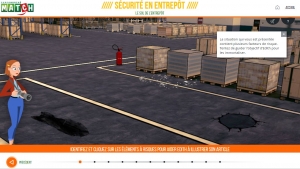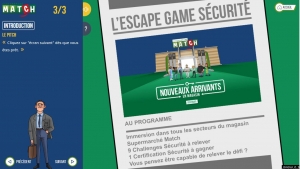Every company must provide safety training for employees upon their arrival. This training aims to inform employees about the preventive measures to be applied and the actions to be taken in case of an accident. Safety training should notably cover topics such as movement within the company premises, work execution conditions, and the actions to take in case of an accident. For a long time, these training sessions took place in face-to-face settings, which were occasionally successful due to the presence of an engaging trainer, but often… they were long and boring. Indeed, the welcoming of new employees is a crucial moment during which a positive image of the company should be established in their minds to promote integration, trust, and safety.
Indeed, an increasing number of companies are choosing to leverage Digital Learning to enhance the engagement of their new employees through comprehensive and engaging learning journeys based on e-learning modules or serious games. The main objectives pursued are primarily:
- Instill a corporate culture and strengthen commitment
- Make the training more appealing through a tool tailored to digital natives
- Improve the retention of information delivered and thus enhance safety by transitioning from a passive to an active mode
- Lighten the schedules of managers and occasional trainers
- Streamline the training process by having the ability to train at any time.
- Reduce the training time.
Audace has thus been involved in creating several onboarding programs for clients as diverse as Orano (welcoming contractors in nuclear power plants), Poivre Rouge (welcoming team members in restaurants), Parc Astérix (welcoming new seasonal employees), Supermarchés Match (welcoming new hires in fresh warehouses, dry warehouses, and stores)…
The winning combination for this type of program remains more or less the same: inductive pedagogy, gamification, and information retrieval.
Inductive pedagogy is based on the approach of addressing knowledge items through questioning and challenging the learner. In a second step, what we call “feedback” delivers knowledge in a clear and precise manner. The benefit of this method is to make the learner truly engaged in their learning process.
Gamification, on the other hand, aims to create emotion. Without attention, there is no understanding, and therefore no memorization. To achieve that, there is a prerequisite: creating a “positive emotion.” To do so, it is necessary to rely on motivational factors such as presenting puzzles that tap into our desire to find solutions, offering rewards, arousing curiosity to provoke the desire to explore and discover, and creating surprise through the use of irony, metaphor, and unexpected elements.
Finally, to ensure memorization, it is essential to encourage information recall through formative assessments throughout the course and summative assessments at the end of the course.
In certain cases (for complex concepts or significant risks), it can be beneficial to combine the initial onboarding modules with spaced learning, which aims to combat the forgetting curve. The implementation method of such additional training relies on several evaluation phases to adjust the content to the learner’s reality. The evaluations help identify the concepts on which the learner has more or less difficulty.
To do this, the evaluations are divided by “themes” (or concepts) in order to easily analyze the results obtained. The idea is therefore to create a “question bank” so that the tool can adjust the different evaluation phases to the learner’s results by selecting the appropriate questions at each phase (without ever repeating them).
A crucial element in implementing a “spaced learning” tool is the timing between different evaluation phases. Ideally, the reminders should be positioned at the exact moment when the learner starts to forget. Determining that moment is complex since each learner has different predispositions for retaining information.
The algorithm developed by scientist Piotr Wozniak provides a “rational” approach to the concept of forgetting and allows for the definition of a schedule (adapted to the desired level of memorization): Day 7, Day 16, Day 35, for example.
Having doubts ? Join Edith Aurial, a renowned journalist for a well-known magazine specialized in distribution, as the main character in the “Warehouse Safety Welcome” e-learning collection from Supermarchés MATCH, a leading retail chain. With her assistance, gain an understanding of the operations of a fresh or dry warehouse at MATCH, identify the main risks involved, and learn and apply the essential safety rules. Welcome on board!
Discover the project with pictures



